“Karbandi Goemba” or “Kharbandi Monastery” was the first Buddhist temple that we visited in Bhutan. And also the first tourist spot that we stopped at on our 7 days trip to Bhutan. On the first day after entering Bhutan, while on our way from Phuentsholing to Thimphu. As our vehicle pulled in hardly after 30 minutes drive from the border. All I could initially see was the sign to the “Kharbandi Monastery”. And a wide gate which was wide open. Little then I knew that I was going to step into one of the oldest Buddhist Temples of Bhutan. With rich history, beautiful architecture and jaw dropping backgrounds.
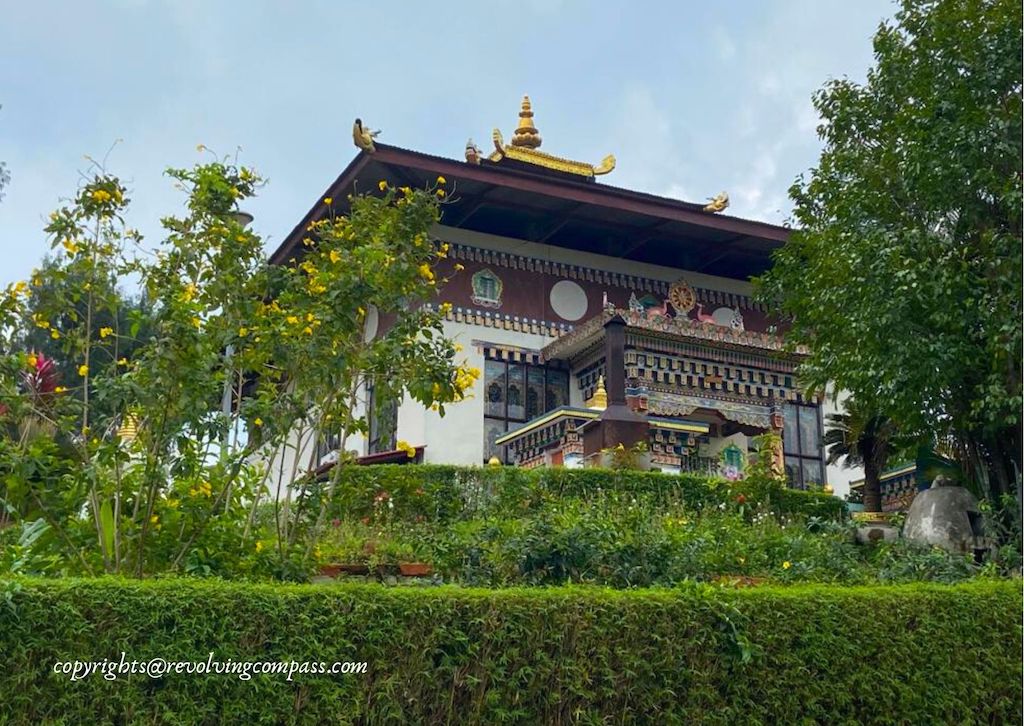
So, without further delay, let me take you on a tour of the Kharbandi Monastery with me. But before that, I have accumulated a lot of resources for you from our Bhutan trip. And here’s a list of these resources :
A complete guide to Bhutan – covering all the information that you will like to know when planning a trip to Bhutan
The complete process of obtaining Bhutan Permit for Indian citizen, including the documentation requirement, passport validity requirement and everything else.
Let us take you on this virtual tour of the Punakha Dzong – one of the largest Dzongs of Bhutan
Take this tour of the Punakha Valley in Bhutan with us and know why Punakha Valley must be included into our list of places to visit in Bhutan
More resources :-
Places to see in Thimphu in one day
An adventure on Punakha Suspension Bridge
Trekking to Tigers Nest Monastery
Driving to Kharbandi Monastery Bhutan
PS: It’s very popular to self drive in Bhutan. And I can image the experience one will have if self driving through these picturesque locations like the Kharbandi Monastery view point. But, since September 2022, the Bhutan government has imposed a daily fee on vehicles coming in from outside Bhutan. If you can afford that, I highly encourage driving on your own through Bhutan. It is a once in a lifetime experience. Also, Indian driving license works in Bhutan. If you are coming from any other part of the world, you can always get your international driver’s license online for self driving experience in Bhutan.
Basic Info on the Kharbandi Monastery
The royal grandmother, Ashi Phuntsho Choedron built the Kharbandi Monastery in 1967. Legends say that when a childless lady prayed here with all her heart, asking to be blessed with a child, her prayers came true. Since then, Kharbadi Monastery rose in it’s popularity. Particularly among childless couples. However it is equally visited by other tourists of faith. As well as those who want to enjoy the serene atmosphere and breathtaking views around this complex.
Timings of Kharbandi Monastery : 7:00 AM – 6:00 PM
Time Required to visit the Buddhist Temple completely : 2-3 hours
Entry Fee of Kharbandi Monastery : No entry fee at the time of this writing
Entering inside the Kharbandi Monastery
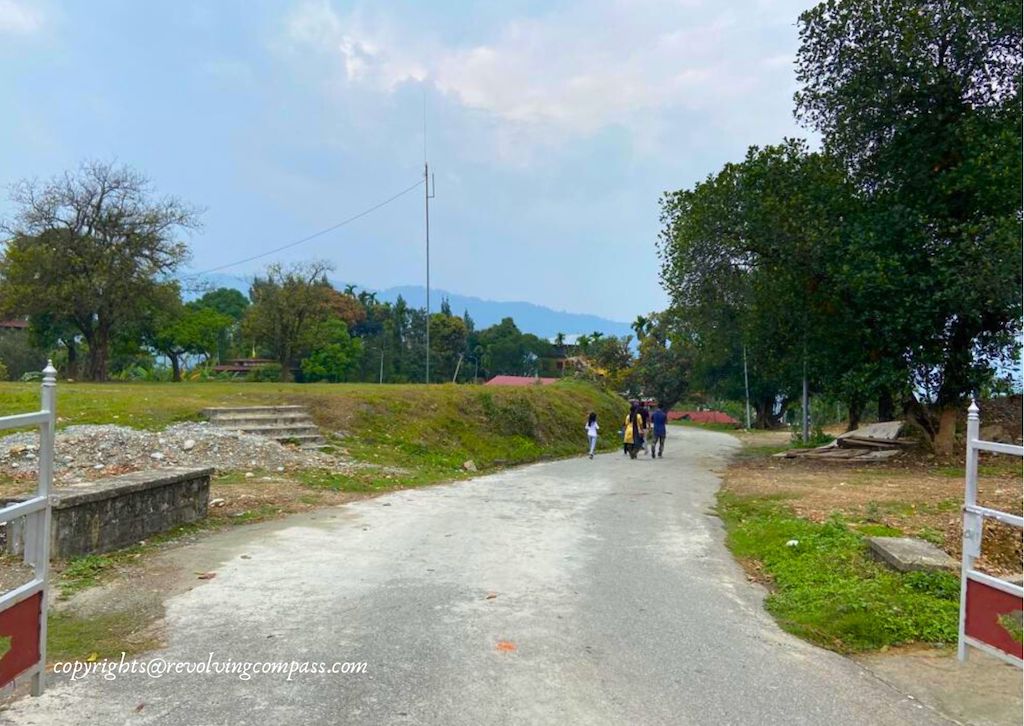
As we parked our vehicles near the main gate and entered inside, we didn’t really get a proper glimpse of the Kharbandi Monastery at first. There is a paved walkway to walk inside. Which curves a little as you go further. Giving you the first proper glimpse of the Monastery. But only after you have walked some 200-300 meters inside. We reached here around 12 pm. And there was hardly anyone inside apart from us and couple of other tourists. But, just like any other monastery, the atmosphere inside the Kharbandi Monastery seemed to be charged with a mystical positive energy. The rustling of the flags were a familiar sound. So was the melodious sound coming from the rotation of the prayer wheels.
Views from the Kharbandi Monastery
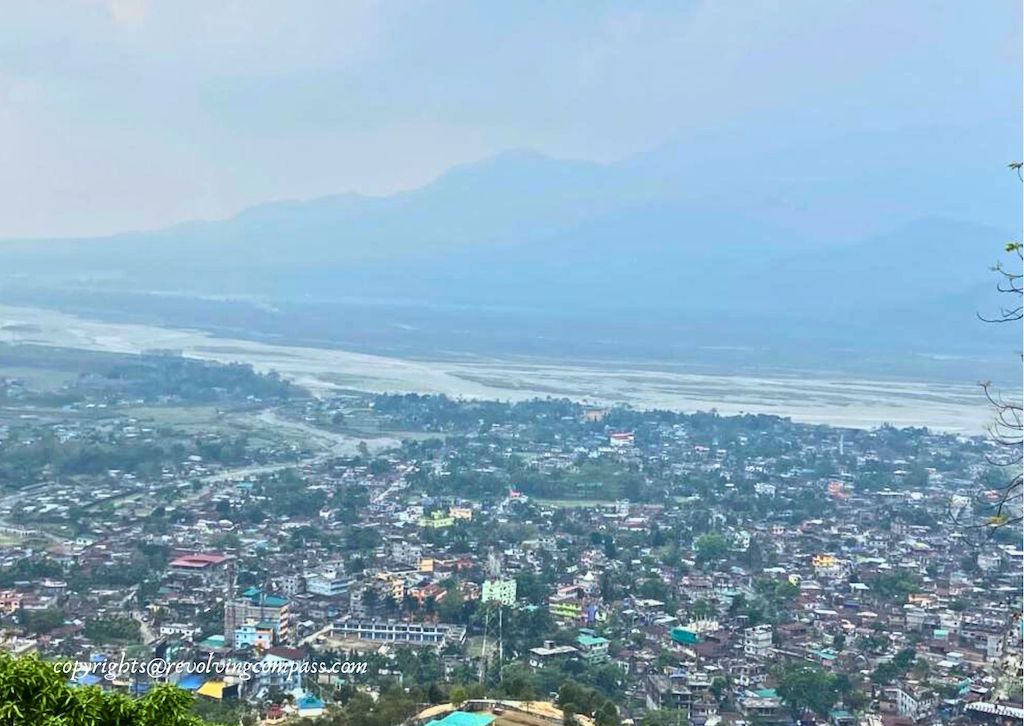
Kharbandi Monastery is located just 300 – 400 meters above the sea level. Overlooking the vast valley of Himalayas that hosts the town of Phuentsholing in Bhutan and Jaigaon across the border in India. Across a vast river bed, with the huge mountains in the backdrop, you can see far and wide from here. Which made me wonder if this monastery ever served a purpose more than what it was designed for. Because it’s location seemed so strategic. But our guide couldn’t shade any light on that. So, it was established as a place of peace and prayers. Although, we were too mesmerised by the views around the monastery. That we had to really tear ourselves apart from it to focus on the actual monastery. And what our guide was telling about it. As the main monastery faces right into these views!
The Stupas at Kharbandi Monastery
Right opposite to the valley, there is a flight of stairs to go up the main premises of the monastery. But before that, what caught my attention was several similar looking stupas in front of me, besides the stairs with some details inked on marble for each one of them. Clearly, each one of these stupas were very important. As, each one of these stupas is based on an important stupa which was constructed somewhere in India or Nepal co-memorating an important event from the life of Lord Buddha. Later, when this temple was constructed, a replica of each such stupa was constructed here to represent all the different important events from the life of Lord Buddha at one place. And I will tell you here about a few of them before we move on –
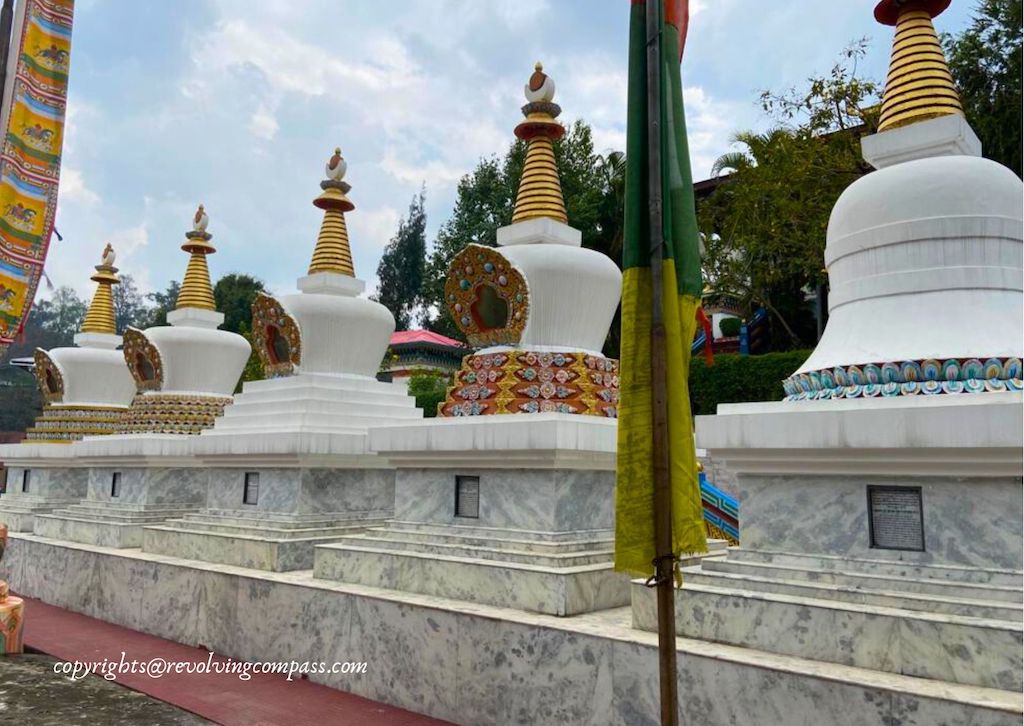
Story behind all the stupas at Kharbandi Monastery
LIIA BAABS MCHODRTEN – This one is constructed by the people of Kasi. When Lord Buddha at the age of 42 visited the 33rd abode of Gods to meet his mother and preached her the sermons on the important religious texts!! The stupa seen at Kharbandi Monastery was built by the Royal Mother in the memory of that event.
RNAM RGYAL MCHODRTEN – This stupa was constructed by the Devas when Lord Buddha at the age of 80 decided to enter Mahaparinirvana in Vaishali district of Bihar, India. But then on request of upasak Chunds, extended his life by 3 months. In the memory of that stupa, this stupa was built by the Royal Mother.
PAD-SPUN BDE GSEGSBYUN BA’I MCHODRTEN – This type of stupa was first constructed in the memory of the birth of Lord buddha at Kapilvastu in the Lumbini Garden. The Stupa in this monastery is a replica built in the memory of the original stupa at Lumbini gardens to co-memorate the same event.
BDUD SUL BYAN-CHUB MCHODRTEN – This stupa was built by the King Bimbisara when Lord Buddha attended enlightment under the Bodhi Tree in Magadh, which is known as Bodh Gaya in Bihar now. This stupa was newly built by the royal mother of Bhutan in 1967
DGE-DUN DBYEN-ZLUM MCHODRTEN – This type of stupa was built by the people of Magadha when during the time of lord Buddha, his two chief disciples brought unity amongst the monks living in veluvana who were torn apart by the Devdatta’s slander earler.
DGONS-PA MYAN DAS CHODRTEN – This type of stupa was built by the citizen of Magadha when lord Buddha at the age of 80 years finally took the mahanirvana and passed through several stages of “samadhi” .
Inside the Kharbandi Monastery
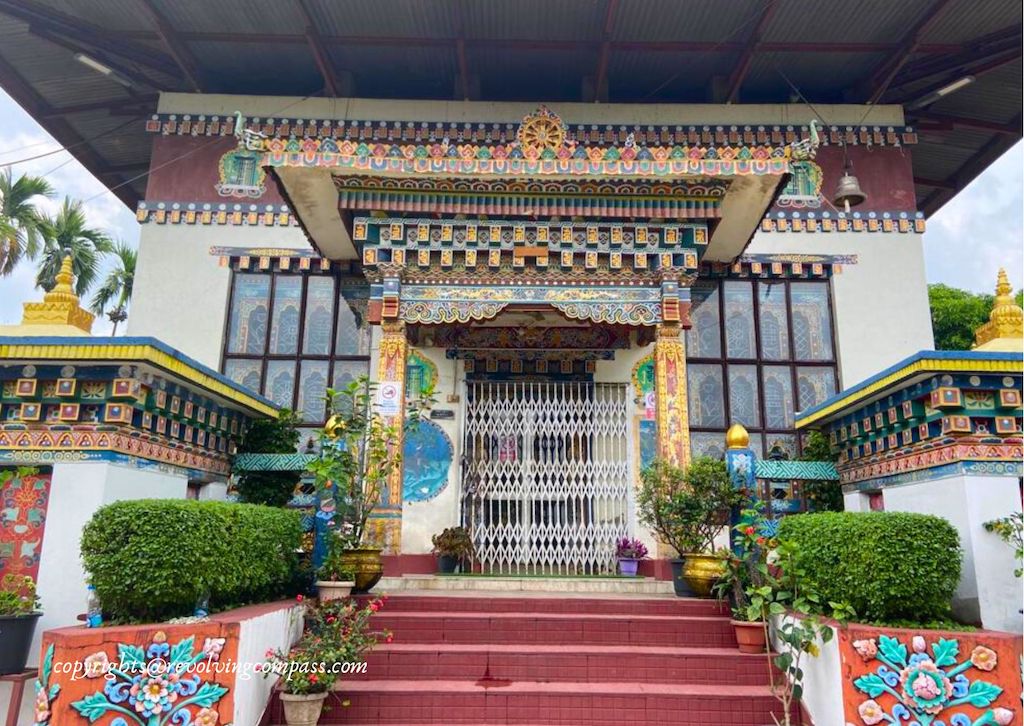
After going through the Stupas, looking at their inkings and understanding their history, we went up the stairs to the main monastery. As always, photography was not allowed inside the Kharbandi Monastery. Although the main monastery shrine consists of statues of the Shakyamuni Buddha, Shabdrung Ngawang Namgyal, and Guru Rinpoche .Outside the main shrine, there were prayer wheels. As we took a circle around the building, we rotated the prayer wheels. Although we don’t know what prayers are said while rotating the prayer wheels. But I guess that doesn’t matter as long as it is done with a pure heart and the best intents.
From here, we traced our steps back to the main door of the monastery. But not without stopping once again to take in the breathtaking views of the valley below.
General tips on visiting the Kharbandi Monastery in Phuentsholing
- You should open your shoes before you visit the main shrine inside the monastery. Better to open the shoes before you climb the stairs. It is done out of respect. There is on one around the monastery to force you to do it. So, it is upto each one of us.
- Wear comfortable cotton cloths and walking shoes for daytime in summer months and a light jacket in the winter months. You might face a lot of wind here as there is unobstructed open space behind the monastery.
- It is one of the few places in Bhutan where you will find least crowd. Although none of the other places are really crowded but I found the least crowd here so you can take your time to explore around.
- Restroom facilities are available on the premises.
- Your guide will tell you about the place in details. However, it’s good to do a research on places afterwards. Unfortunately I am finding through comments on the previous posts that many of the stories that our guide told us during this trip are not really accurate enough.
- Around 2-3 hours enough to visit here and explore around thoroughly.
PS: On the first day of our trip to Bhutan, we stayed overnight in Jaigaon, the Indian town bordering with Phuentsholing. And the next day, we crossed the border and started our journey into Bhutan. This was a road trip from Phuentsholing to Thimphu. And we visited Kharbandi Monastery as a part of this trip. If you are short on time, while on your way to Thimphu. Then you can as well visit here on your way back from Thimphu to Phuentsholing. As the highway you will take when returning from Bhutan to India is exactly the same.
PS: Some of our links are affiliated, this means we will earn a commission when you buy a service or product by clicking those links. However, this will have no extra cost for you.